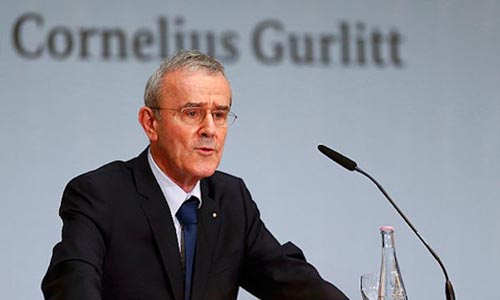
BERLIN, Germany (WJC) — The Kunstmuseum Bern on Monday agreed to accept artworks from the collection of Hildebrand Gurlitt, whose son Cornelius Gurlitt willed them to the museum in the Swiss capital shortly before his death last April.
The head of the museum’s Board of Trustees, Christoph Schäublin, told a press conference in Berlin that his institution would accept only artworks which had not been looted by the Nazis.
The museum discovered in May that it had been named sole heir of Cornelius Gurlitt, a recluse who secretly kept his father’s collection of more than 1,200 artworks hidden for decades until tax inspectors stumbled upon them on a visit to his Munich apartment in 2012.
The trove of Modernist and Renaissance masterpieces, which includes works by Chagall and Picasso, was assembled by his father Hildebrand, an art dealer charged with selling what Hitler called “degenerate” art.
An agreement between the Federal Republic of Germany, the State of Bavaria and Cornelius Gurlitt of 3 April 2014, would be honored by the Kunstmuseum Bern, Schäublin told reporters in Berlin. He promised that his museum would strictly apply the 1998 Washington Principles on the return of looted art, and that “no looted art work will enter the Kunstmuseum.”
“The board’s decision was anything but easy, and there certainly weren’t emotions of triumph as these would be entirely inappropriate considering the historic burden weighing heavily on this art collection,” Schäublin declared. He also said that the task force set up by Germany a year ago would continue to investigate the provenance of all suspicious artworks found in Gurlitt’s Munich apartment and will also investigate hundreds of pictures found earlier this year at the Salzburg house of Gurlitt. Should further artworks in Gurlitt’s estate emerge, the Bern museum is pledging to turn them over to the task force to check their provenance.
All works whose provenance is suspicious will remain in Germany until the task force has completed its work. For each of these works, the task force will present a report on the provenance of the work or a report on the status of its research sometime next year.
If a work has proved to be Nazi-looted art or is very likely to be Nazi-looted art, the report on the provenance of that work will be published on the website www.lostart.de. The German government will, at its own expense and on its own responsibility, return the work to its rightful owner, if one has already been identified. If no rightful owner has been identified, the work will be exhibited in Germany with an explanation of its origins, so that rightful owners will have the opportunity to submit their claims. In this case as well, the Federal Government will return the work to its rightful owner.
If it is impossible for the research of the task force to determine with sufficient clarity whether a work is Nazi-looted art or not, the agreement stipulates that it will be up to the Kunstmuseum Bern to decide whether it will take in the work. If the museum decides to take the art work, it will bear sole responsibility for it from the moment it makes that decision. Otherwise, the work will remain in Germany. The provenance reports of these works will also be published at www.lostart.de and the works will be exhibited with the aim of complete transparency, according to the agreement. If any of these works are later found to be Nazi-looted art and a rightful owner has been identified, the German government will return the work to its rightful owner.
Works that the Task Force finds are not Nazi-looted artworks will be turned over to the Bern museum, which will bear sole responsibility for them from that moment on. The same will apply to works that, in the absence of a rightful owner or in the absence of conclusive results by the Task Force, are exhibited, if it is proved by the end of 2020 that the works are not Nazi-looted art. Otherwise the Kunstmuseum will surrender all its claims to these works after the end of 2020, according to a statement published on Monday.
Gurlitt’s estate also includes another group of works: those defamed by the Nazis as “degenerate art” and removed from publicly owned museums and collections. According to the agreement, the Kunstmuseum Bern will take these works (as long as they are not Nazi-looted art and therefore to be dealt with according to the rules just described) and make sure they receive proper care.
Bern will give priority to loan requests from museums that owned the works before the Nazi campaign against “degenerate art” and will grant these requests as far as the condition of the works allows it.
*
Preceding provided by the World Jewish Congress